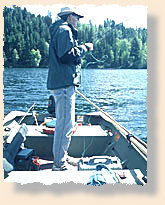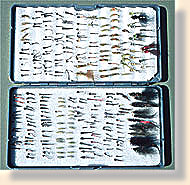For anyone who loves stillwater trout fishing or has a yen to get started in
this frustrating but rewarding fly-fishing pursuit the Southern Interior
Region of British Columbia is stillwater trout central.

KAMLOOPS, British Columbia, As I sat comfortably in my pontoon boat, bobbing around
on long, L-shaped Paul Lake, not many miles out of the town of Kamloops,
British Columbia I gazed at a wispy veil of clouds slipping lazily across
an incredibly blue sky. Although I was very slowly retrieving a tiny red-butt
chironomid that was riding deep on the end of a sinking fly line, my mind
was fixated on the scenery. The hills encircling Paul Lake were blanketed
in conifers and beachfront homes were scattered along the shore. My aimless
retrieve of the chironomid pattern continued until the tip of my 5-weight
fly rod suddenly slammed into the water and the line sliced painfully across
my fingers before I could let go. Thirty feet away the surface opened in
an explosion of a million sparkling diamonds as a fat Kamloops rainbow trout
careened into the morning sunlight.
When the big rainbow returned to the water it immediately surged away, taking
the remaining 60-feet of fly line off the reel and raking the backing
splice through the rod guides for another 50 feet or more. Suddenly the
trout roared through the surface again, fell back and yanked off another
40 feet of backing. My little click-drag reel was screaming as I attempted
to slow the run of the big rainbow with the palming rim. On the third
jump, even higher than the first two, the thick-bodied trout severed our
relationship before crashing back into the lake.
Kamloops and surrounding areas: Your first glimpse of Kamloops
will likely be a surprise. This bustling little metropolis has all the
comforts of a much larger city including hotels, restaurants, auto
rentals, fishing shops and more. And, all of it is surrounded by a
mecca of great Kamloops trout fishing lakes, many within a few
minutes drive. For more information on Kamloops, click on:
City
of Kamloops or Kamloops.com
When to go:
Local anglers start fishing as soon as ice leaves the lower elevation
lakes around Kamloops, which is in mid to late April. However, anyone
heading for Kamloops south over Coquihalla Pass in April always
runs the risk of slick roads and avalanches blocking the road. Heading
in from other directions there is Pennask Summit, Monashee Pass
and Bonanza Pass to name a few that can make you pucker up a bit
during the winter-to-spring transition. So most anglers figure that
the time to hit the Kamloops country lakes begins in mid-June or
thereabouts with good fishing lasting until October.
Nuts! I muttered to myself. My shoulders slumped and I began to wind in my line
to check the fly. It was the second successive Kamloops rainbow trout
that had picked up the gauntlet then proceeded to clean my clock. The
first one had preformed an aerial pirouette and spit the hook. As I examined
my leader tippet I discovered that the second one had snapped the 4X leader
point and departed with my fly.
I decided to row my pontoon boat ashore and have lunch. Shore was actually
a small but very well kept British Columbia Provincial Park complete with
trimmed grass, a scattering of fir trees and several picnic tables. In
short order I negotiated the 50 feet or so to shore, got a small ice chest
from the back of my battered but unbowed Pathfinder and selected a nearby
picnic table. My lunch, a spread from a local Kamloops deli, consisted
of a pastrami sandwich, large dill pickle and a bottle of cold Kokanee
Beer, a good Canadian brew. When I finished off lunch and drained the
last of the Kokanee I decided to call it a day at Paul Lake. It had been
a long drive from Seattle to Kamloops and tomorrow I would be fishing
on Heffley Lake with renowned Kamloops fish biologist Brian Chan.
When it's hot, it's hot
"OK Les, this is the spot," Brian said when he stopped after a 3-mile
run up Heffley Lake in his 14-foot johnboat. "We have 19 feet of
water under the boat and it should be fishing well right about now."
After setting two anchors to keep the boat from turning in the wind, he
dug a fly box out of his bag and handed me a small, brass-ribbed chironomid.
"This has been the hot one recently," he noted. "Fish it on a full-sinking
fly line and let it get to the bottom before you retrieve. And…retrieve it very
slowly."
|





